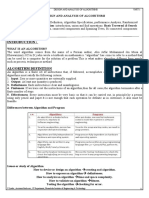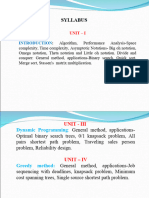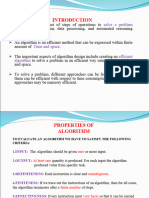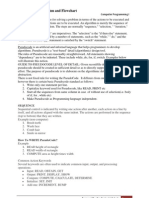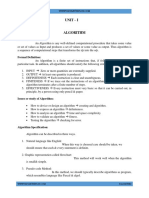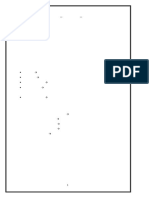0 ratings0% found this document useful (0 votes)
6 views1.2 Algorithm Specification
Uploaded by
shinchankolliCopyright
© © All Rights Reserved
Available Formats
Download as PPTX, PDF, TXT or read online on Scribd
0 ratings0% found this document useful (0 votes)
6 views1.2 Algorithm Specification
Uploaded by
shinchankolliCopyright
© © All Rights Reserved
Available Formats
Download as PPTX, PDF, TXT or read online on Scribd
You are on page 1/ 13
1.
2 ALGORITHM SPECIFICATION
Algorithm can be described in three ways.
1. Natural language like English: When this way is choose care
should be taken, we should ensure that each & every statement is
definite.
2. Graphic representation called flowchart: This method will work
well when the algorithm is small& simple.
3. Pseudo-code Method: In this method, we should typically describe
algorithms as program, which resembles language like PASCAL &
ALGOL
1.2.1 PSEUDO CODE CONVENTIONS
What is a Pseudo Code?
Pseudo code is a compact and informal high-level description of a
computer programming algorithm that uses the structural
conventions of some programming language.
Pseudo code is an artificial and informal language that helps
programmers develop algorithms.
Pseudo code is a ”text-based” detail(algorithmic) design tool.
Flow charts can be thought of as a graphical alternative to pseudo
code.
A Flow chart is a schematic representation of an algorithm, or the
step-by-step solution of a problem, using some geometric figures.
PSEUDO CODE CONVENTIONS
The following are set of rules need to be followed while writing
algorithms
1. Comments begin with // and continue until the end of line.
2. Blocks are indicated with matching braces { and }. A compound
statement can be represented as a block. The body of a procedure
also forms a block. Statements are delimited by ;.
3. An identifier begins with a letter. The data types of variables are
not explicitly declared. Whether a variable is local or global to a
procedure will also be evident from the context.
PSEUDO CODE CONVENTIONS
4. Compound data types can be formed with records. Here is an
example,
Node= Record
{
data type – 1 data-1;
... ... ... ... ... ...
data type – n data – n;
node * link;
}
Here link is a pointer to the record type node. Individual data items of
a record can be accessed with and period.
5. Assignment of values to variables is done using the assignment
statement.
<Variable>:= <expression>;
PSEUDO CODE CONVENTIONS
6. There are two Boolean values TRUE and FALSE.
Logical Operators AND, OR, NOT
Relational Operators <, <=,>,>=, =, !=
7. The Looping statements are employed are: For, while and repeat-until
While Loop:
While < condition > do
{
<statement-1>
...
<statement-n>
}
As long as condition is TRUE, the statements get executed. When
condition becomes FALSE, the loop is exited. The value of condition is
evaluated at top of the loop.
PSEUDO CODE CONVENTIONS
The general form of For loop is
For Loop:
for variable: = value_1 to value_2 step step do
{
<statement-1>
...
<statement-n>
}
Here value 1, value 2 and step are arithmetic expressions. A variable of
type integer or real or a numerical constant is a simple form of an
arithmetic expression. The clause “step step” is optional and taken as
+1 if it does not occur. Step could either be positive or negative.
Variable is tested for termination at the start of each iteration.
PSEUDO CODE CONVENTIONS
The repeat-until loop is constructed as follows.
repeat-until:
repeat
<statement-1>
...
<statement-n>
until<condition>
The statements are executed as long as condition is false. The
value of condition is computed after executing the statements. The
instruction break; can be used within any of the above looping
instructions to force exit. In case of nested loops, break; results in the
exit of the innermost loop that it is a part of. A return statement within
any of the above also will result in exiting the loops. A return statement
results in the exit of the function itself.
PSEUDO CODE CONVENTIONS
8. A conditional statement has the following forms.
If <condition> then <statement>
If <condition> then <statement-1>else <statement-1>
Here condition is the Boolean expression and statements are arbitrary
statements.
Case statement:
Case
{
<condition-1> : <statement-1>
...
<condition-n> : <statement-n>
else : <statement-n+1>
}
PSEUDO CODE CONVENTIONS
Here statement 1, statement 2 etc. could be either simple statement
or compound statements.
A case statement is interpreted as follows. If condition 1 is true,
statement 1 gets executed and case statement is exited. If statement
1 is false, condition 2 is evaluated. If condition 2 is true, statement 2
gets executed and the case statement exited and so on.
If none of the conditions are true, statements + 1 is executed and the
case statement is exited. The else clause is optional.
9. Elements of multidimensional arrays are accessed using [ and ]. For
example, if A is a two dimensional array, the <i,j>th element of an
array is denoted as A[i,j].
10. Input and output are done using the instructions read & write.
PSEUDO CODE CONVENTIONS
11. There is only one type of procedure:
Algorithm, the heading takes the form,
Algorithm Name (Parameter lists)
Where Name is the name of the procedure and parameter list is a
listing of the procedure parameters.
The body has one or more statements enclosed with braces { and }.
An algorithm may or may not return values. Simple variables to
procedures are passed by value.
Arrays and records are passed by reference.
An array name or record name is treated as a pointer to the
respective data type.
PSEUDO CODE CONVENTIONS
• As an example, the following algorithm fields & returns the
maximum of ‘n’ given numbers.
Algorithm Max(A,n)
// A is an array of size n
{
b := A[1];
for i:= 1 to n do
if A[i] > b then
b :=A[i];
return b;
}
• In this algorithm (named Max), A & n are procedure parameters. b &
i are Local variables.
Discuss the Pseudo code conventions for expressing algorithms.
[7M] [R16 November - 2019 III-II Supplementary]
Write different pseudo code conventions used to represent an
algorithm.[7M][R16-Set-1 April/May – 2019 III-II Regular]
You might also like
- R19 It Iii Year 1 Semester Design and Analysis of Algorithms Unit 1No ratings yetR19 It Iii Year 1 Semester Design and Analysis of Algorithms Unit 139 pages
- EContent 1 2023 10 25 18 46 33 UNIT1PPTSDAAppt 2023 07 20 15 12 39No ratings yetEContent 1 2023 10 25 18 46 33 UNIT1PPTSDAAppt 2023 07 20 15 12 3972 pages
- Design and Analysis of Algorithms ModuleNo ratings yetDesign and Analysis of Algorithms Module53 pages
- JNTUA Advanced Data Structures & Algorithms Notes R20No ratings yetJNTUA Advanced Data Structures & Algorithms Notes R20150 pages
- EST102: Programming in C: The World of Problem SolvingNo ratings yetEST102: Programming in C: The World of Problem Solving18 pages
- DAA Unit1 pptsTillAymptoticNotationpptx 2024 07 19 12 01 06No ratings yetDAA Unit1 pptsTillAymptoticNotationpptx 2024 07 19 12 01 0651 pages
- Lecture 1 (6 Files Merged) (6 Files Merged)No ratings yetLecture 1 (6 Files Merged) (6 Files Merged)81 pages
- Design and Analysis of Algorithm notes pdf3No ratings yetDesign and Analysis of Algorithm notes pdf3156 pages
- Purpose of Database - Overall System Structure - Entity Relationship Model - Mapping Constraints - Keys - ER DiagramNo ratings yetPurpose of Database - Overall System Structure - Entity Relationship Model - Mapping Constraints - Keys - ER Diagram11 pages
- Design and Analysis of Algorithms Study MaterialNo ratings yetDesign and Analysis of Algorithms Study Material121 pages
- BE EXPERT IN JAVA Part- 2: Learn Java programming and become expertFrom EverandBE EXPERT IN JAVA Part- 2: Learn Java programming and become expertNo ratings yet
- 5V_s_of_Big_Data_Attributes_and_their_ReNo ratings yet5V_s_of_Big_Data_Attributes_and_their_Re10 pages
- CCTV Bosh Datasheet - Data - Sheet - enUS - 24097715595No ratings yetCCTV Bosh Datasheet - Data - Sheet - enUS - 240977155956 pages
- Acceptance of E-Banking Among Adult Customers An Empirical Investigation in IndiaNo ratings yetAcceptance of E-Banking Among Adult Customers An Empirical Investigation in India18 pages
- Nokia Threat Intelligence Report 2021 Report ENNo ratings yetNokia Threat Intelligence Report 2021 Report EN24 pages
- The Basics of Python For Loops A Tutorial - Learn Data Science With DataquestNo ratings yetThe Basics of Python For Loops A Tutorial - Learn Data Science With Dataquest1 page
- Specification For Carbon Steel Piping MaterialsNo ratings yetSpecification For Carbon Steel Piping Materials8 pages
- Georeferencing and Digitization in QGISNo ratings yetGeoreferencing and Digitization in QGIS82 pages
- Sri Vidya College of Engineering & Technology Course Material (Lecture Notes)No ratings yetSri Vidya College of Engineering & Technology Course Material (Lecture Notes)26 pages
- Progress Test 5 (Modules 9-10) : Expert PTEA Testmaster B2No ratings yetProgress Test 5 (Modules 9-10) : Expert PTEA Testmaster B27 pages
- R19 It Iii Year 1 Semester Design and Analysis of Algorithms Unit 1R19 It Iii Year 1 Semester Design and Analysis of Algorithms Unit 1
- EContent 1 2023 10 25 18 46 33 UNIT1PPTSDAAppt 2023 07 20 15 12 39EContent 1 2023 10 25 18 46 33 UNIT1PPTSDAAppt 2023 07 20 15 12 39
- JNTUA Advanced Data Structures & Algorithms Notes R20JNTUA Advanced Data Structures & Algorithms Notes R20
- EST102: Programming in C: The World of Problem SolvingEST102: Programming in C: The World of Problem Solving
- DAA Unit1 pptsTillAymptoticNotationpptx 2024 07 19 12 01 06DAA Unit1 pptsTillAymptoticNotationpptx 2024 07 19 12 01 06
- Purpose of Database - Overall System Structure - Entity Relationship Model - Mapping Constraints - Keys - ER DiagramPurpose of Database - Overall System Structure - Entity Relationship Model - Mapping Constraints - Keys - ER Diagram
- BE EXPERT IN JAVA Part- 2: Learn Java programming and become expertFrom EverandBE EXPERT IN JAVA Part- 2: Learn Java programming and become expert
- CCTV Bosh Datasheet - Data - Sheet - enUS - 24097715595CCTV Bosh Datasheet - Data - Sheet - enUS - 24097715595
- Acceptance of E-Banking Among Adult Customers An Empirical Investigation in IndiaAcceptance of E-Banking Among Adult Customers An Empirical Investigation in India
- The Basics of Python For Loops A Tutorial - Learn Data Science With DataquestThe Basics of Python For Loops A Tutorial - Learn Data Science With Dataquest
- Sri Vidya College of Engineering & Technology Course Material (Lecture Notes)Sri Vidya College of Engineering & Technology Course Material (Lecture Notes)
- Progress Test 5 (Modules 9-10) : Expert PTEA Testmaster B2Progress Test 5 (Modules 9-10) : Expert PTEA Testmaster B2





